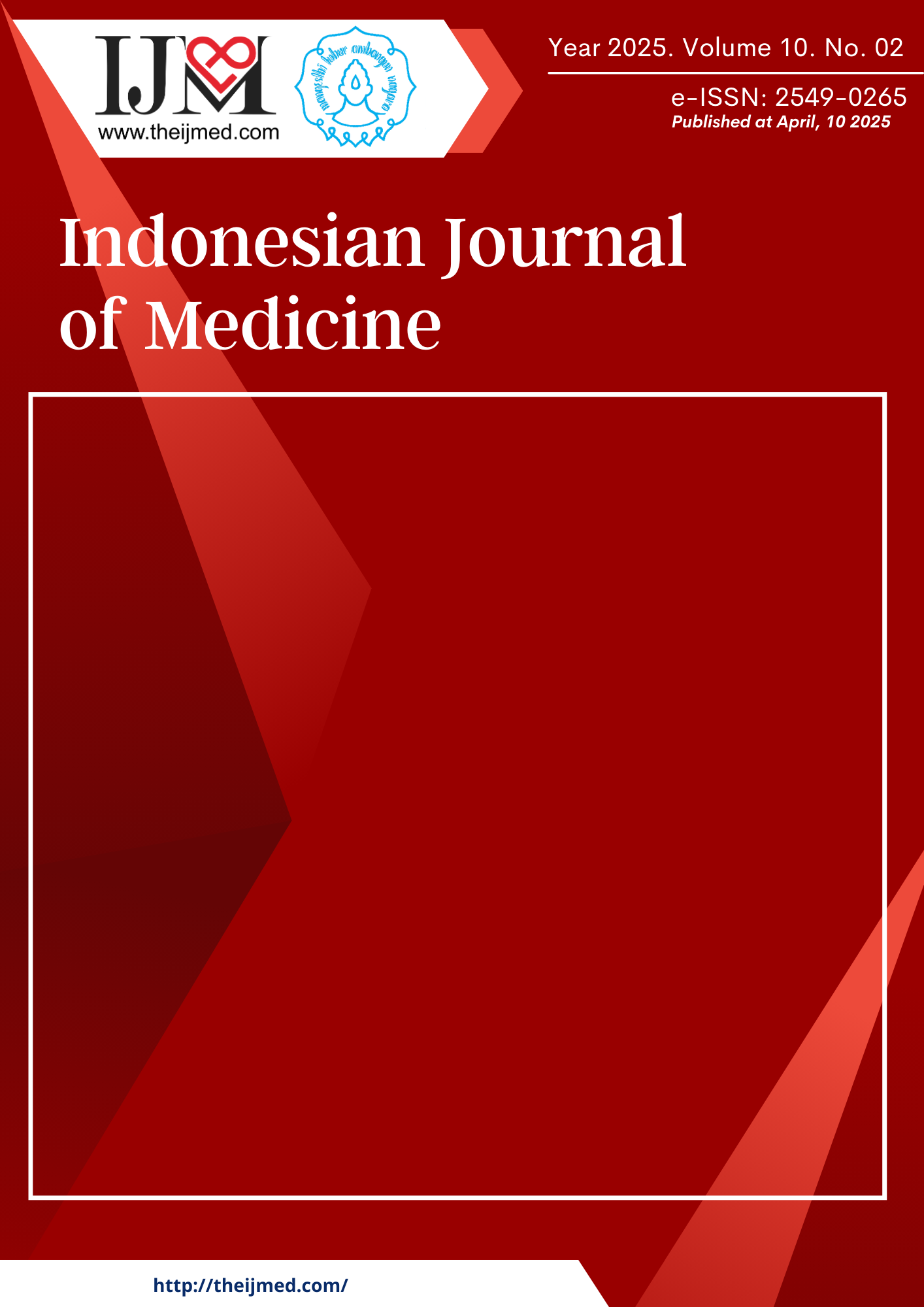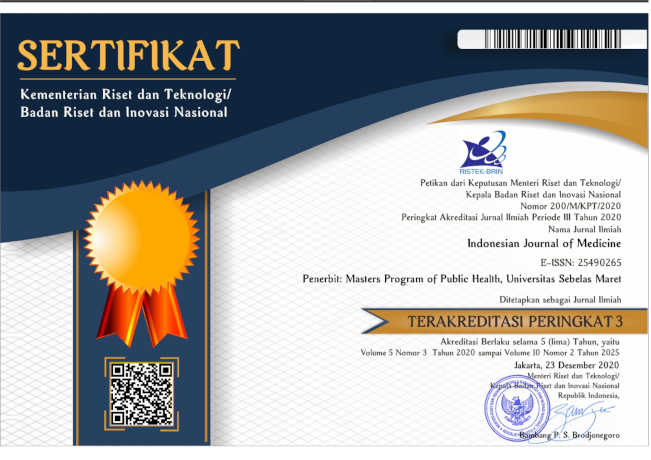Septic Shock and Multi-Organ Dysfunction Syndrome in a Patient with Extensive Tophaceous Gout, Diagnostic and Management Challenges in South Papua: A Case Report
DOI:
https://doi.org/10.26911/theijmed.2025.10.2.824Abstract
Introduction: Septic shock and multiple organ dysfunction syndrome (MODS) are interrelated medical conditions arising from the body's response to severe infection. Extensive tophaceous gout is recognized for its potential to worsen kidney failure, thereby negatively impacting the prognosis of patients suffering from septic shock and MODS.
Case presentation: This case report describes a male patient in his 40s who presented to the emergency department in an unresponsive state and was diagnosed with septic shock, likely secondary to pneumonia, which progressed to MODS. The patient also had uncontrolled hyperuricemia, resulting in extensive tophaceous gout that may have contributed to renal failure. Despite receiving appropriate fluid resuscitation, vasopressors, and antibiotics, the patient succumbed to severe complications. Key challenges in managing this case included limited diagnostic resources, low health awareness, and unclear health insurance coverage, particularly in the context of medical care in South Papua, Indonesia.
Results: The case illustrates the interplay between chronic gout and acute infection. Hyperuricemia may contribute to renal impairment, weaken immune defenses, and worsen outcomes in septic patients—challenges in health access, diagnostics, and patient awareness further complicated management.
Conclusion: Our case report emphasizes the possible contribution of unmanaged gout to the deterioration of septic shock, leading to MODS.
Keywords:
gout, septic shockReferences
Pant A, Prasai A, Rauniyar AK, Adhikary L, Basnet K, Khadka T (2021). Pneumonia in patients with chronic kidney disease admitted to nephro-logy department of a tertiary care center: A descriptive cross- sectional study. JNMA J Nepal Med Assoc. 59(242): 1000-1003. https://doi.org/10.31729/jnma.7074.
Basodan N, Al Mehmadi AE, Al-Mehmadi AE, Aldawood SM, Hawsawi A, Fatini F, et al. (2022). Septic shock: Mana-gement and outcomes. Cureus, 14(12): e32158. https://doi.org/10.7759/cu-reus.32158.
Bauer M, Gerlach H, Vogelmann T, Preiss-ing F, Stiefel J, Adam D (2020). Mor-tality in sepsis and septic shock in Europe, North America and Australia between 2009 and 2019-results from a systematic review and meta-analy-sis. Crit Care, 24(1):239. https://doi-.org/10.1186/s13054-020-02950-2.
Delgado C, Baweja M, Crews DC, Eneanya ND, Gadegbeku CA, Inker LA, Mendu, et al (2022). A unifying approach for GFR estimation: Recommendations of the NKF-ASN task force on reassessing the inclusion of race in diagnosing kidney disease. J Am Soc Nephrol. 79(2): 268-288. https://doi.org/10.-1681/asn.2021070988.
Fleischmann-Struzek C, Rudd K (2023). Challenges of assessing the burden of sepsis. Med Klin Intensivmed Notf-med. 118(2): 68-74. https://doi.org/-10.1007/s00063-023-01088-7.
Franquet T (2018). Imaging of community-acquired pneumonia. J Thorac Imag-ing. 33(5): 282–294. https://-doi.org/-10.1097/rti.0000000000000347.
Fulton MR, Zubair M, Taghavi S (2025). Laboratory evaluation of sepsis. In Statpearls, Statpearls Publishing. https://www.ncbi.nlm.nih.gov/books/NBK594258/
Gheit Y, Gheit IS, Ierulli J, Mbaga I (2023). Rare case of gout leading to septic arthritis, osteomyelitis, and septic shock in an elderly patient. Cureus. 15(11): e48836. https://doi.org/10.7-759/cureus.48836.
Guarino M, Perna B, Cesaro AE, Maritati M, Spampinato MD, Contini C, De Giorgio R (2023). 2023 update on sepsis and septic shock in adult pati-ents: Management in the emergency department. J Clin Med. 12(9): 3188. https://doi.org/10.3390/jcm12093188.
Hill-McManus D, Soto E, Marshall S, Lane S, Hughes D (2018). Impact of non-adherence on the safety and efficacy of uric acid-lowering therapies in the treatment of gout. Br J Clin Pharma-col. 84(1): 142–152. https://doi.org/-10.1111/bcp.13427.
Hotchkiss RS, Moldawer LL, Opal SM, Reinhart K, Turnbull IR, Vincent JL (2016). Sepsis and septic shock. Nat Rev Dis Primers. 2: 16045. https://-doi.org/10.1038/nrdp.2016.45.
Ilg A, Moskowitz A, Konanki V, Patel PV, Chase M, Grossestreuer AV, Donnino MW. (2019). Performance of the CURB-65 score in predicting critical care interventions in patients admitted with community-acquired pneumonia. Ann Emerg Med. 74(1): 60–68. https://doi.org/10.1016/j.an-nemergmed.2018.06.017.
Lee TH, Chen JJ, Wu CY, Yang CW, Yang HY (2021). Hyperuricemia and pro-gression of chronic kidney disease: A review from physiology and pathoge-nesis to the role of urate-lowering therapy. Diagnostics (Basel). 11(9): 1674. https://doi.org/10.3390/diag-nostics11091674.
Mahadita GW, Suwitra K. (2021). The role of hyperuricemia in the pathogenesis and progressivity of chronic kidney disease. Maced J Med Sci. 9(F): 428–435. https://doi.org/10.3889/-oamjms.2021.7100.
Martin GS (2012). Sepsis, severe sepsis and septic shock: Changes in incidence, pathogens and outcomes. Expert Rev Anti Infect. 10(6): 701–706. https://-doi.org/10.1586/eri.12.50.
Rice JB, White AG, Scarpati LM, Wan G, Nelson WW (2017). Long-term syste-mic corticosteroid exposure: A syste-matic literature review. Clin Ther. 39(11): 2216–2229. https://doi.org/-10.1016/j.clinthera.2017.09.011.
Roughley MJ, Belcher J, Mallen CD, Roddy E (2015). Gout and risk of chronic kidney disease and nephrolithiasis: Meta-analysis of observational studies. Arthritis Res Ther, 17(1):90. https://doi.org/10.1186/s13075-015-0610-9.
Srzić I, Adam VN, Pejak DT (2022). Sepsis definition: What’s new in the treat-ment guidelines. Acta Clin Croat. 61(1): 67–72. https://doi.org/10.204-71/acc.2022.61.s1.11.
Sun GD, Zhang Y, Mo SS, Zhao MY (2021). Multiple organ dysfunction syndrome caused by sepsis: Risk factor analysis. Int J Gen Med, 14: 7159–7164. https:-//doi.org/10.2147/IJGM.S328419.
Zhuang T, Eppler SL, Shapiro LM, Roe AK, Yao J, Kamal RN. (2021). Financial distress is associated with delay in seeking care for hand conditions. Hand (N Y). 16(4): 511–518. https://-doi.org/10.1177/1558944719866889.











